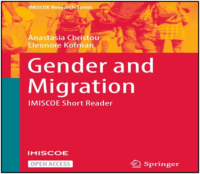Last Updated on June 14, 2022 by themigrationnews

The book ‘Gender and Migration’ is a study of two European scholars Anastasia Christou and Eleonore Kofman on feminisation of migration studies/ migration. The book is published on 08 March 2022 and focuses on recent trends in migration that is during the past thirty or so years. However, the study looks back to the general trends in migration in the colonial era. The book spans 126 pages and is divided into seven chapters. Appended at the end of each chapter is an exhaustive list of sources of the findings in the book.
The book analyses gender-disaggregated data on global migration, which is crucial to addressing the issue of gender equality in migration. The book discusses about Migration as a gendered process. There is a globalised division of labour on the grounds of gender. Gender stereotypes often deter women from exercising autonomy in career choices. The prevalence of such prejudices increases the vulnerability of women to human rights violations in host countries.
In the first chapter ‘Gender and Migration: An Introduction’, the author describes the evolution of gender and development studies that prevailed up to the 1980s. The discussion includes the new concepts of feminisation of migration delineated by some important researchers in the field. However, the concept of feminisation was criticised as too simple by some other scholars. They were of the opinion that the issues vary in complexity in different geographical regions and historical periods. Subsequently, the scope and aims of the book, along with an overview of each chapter, are discussed.
In the second chapter ‘Gendered Migrations and Conceptual Approaches: Theorising and Researching Mobilities’, important theoretical and analytical paradigms are discussed. This includes the concept of intersectionality considered by many scholars as the main contribution made by new feminist scholars. The concept of intersectionality expresses the accumulated prejudices and discrimination occurring due to different factors like gender, caste, race, religion etc. This is quite pertinent to the study of the migrant individuals particularly of women and migrant ethnic groups (p.16). The chapter concludes with an analysis of research and ethical issues involved in migration studies.
Chapter three ‘Gendered Labour’, concerns with empirical studies of gender patterns of migrant labour. Different categories of migrants like labour migrants, family migrants, asylum seekers, refugees and students are available in the labour market. The argument of the authors is that, especially among unskilled and highly skilled categories, women form a substantial portion. This tendency is exemplified in the hospitality sector where relatively unskilled labour is in demand and in academic and professional services where highly skilled labour is required (p. 36). Some studies are focused on women who are new entrants to Information Technology and engineering sectors which have been similar to considered as male bastions.
Chapter four ‘Transnational Families, Intimate Relations, Generations’, discusses aspects of family migration. Family migrations tend to disrupt gender roles. For example, the temporary separation of the spouses which results from many instances of family migration could lead to women spouses getting more responsibilities of bringing up children and hence greater say in the family. This could be termed as an instance of women empowerment. Children of migrant parents who happen to stay either with the mother or the father naturally suffer from the absence of one of the parents. The trauma experienced by some of such children can lead to psychological stress and its attendant physical and mental consequences. Such problems involved in family migration like international intimacy, sexual relationships and the status of children born out of such relationships are now areas of empirical studies and are quoted in detail in this chapter (p. 63).
In chapter five, ‘Gendering Asylum’, the authors discuss the relatively new phenomenon of women taking initiative in migration to European countries. To cite an instance, while males formed the major portion of the ‘Gastarbeiter’ (guest workers) from Turkey, the migrant labour from India was mainly composed of women. The Turkish guest workers gradually brought their women to Germany and made family settlements. In the case of Indian and other migrant laborers who were mainly women serving in care homes and hospitals, male members followed women. The 1951 Refugee Convention conceptualised refugees mainly as males and so the issue of women becoming refugees on their own was sidelined (p. 79). Attempts are being made to rectify this skewed perspective. The second part of the chapter examines the recent migrant refugee crisis caused by conflicts in South Asia, Sub Saharan Africa, North Africa and the Middle East, especially Syria. The first flow of North African and West Asian refugees consisted of mainly men and this gender factor led to the creation of an impression in European societies about the cowardly men fleeing from their homeland who would pose threat to the safety of European societies (p. 83). However, after 2015, as more and more women refugees started knocking at European doors, this prejudice slightly waned.
In chapter six ‘Engendering Integration and Inclusion’, the authors discuss the issue of the integration of the migrant population. Integration of migrants into host societies is a long and complicated process which requires concerted efforts from the host societies and the migrants to accommodate each other successfully. Successful integration can be defined as ‘upward social mobility, no residential segregation, intermarriage, and the potential for equal participation in politics and public activities. Unlike assimilation, integration does not imply losing the culture of the country of origin but actually being able to sustain it while also adapting to a new city’ (p.96). The authors then discuss the issues of integration discourses (p.101) and examine the efforts on the part of the immigrants to challenge discrimination in society and in the workplace and seeking political participation as fully integrated members of European societies.
In the conclusion, the authors highlight the importance of understanding the history of gender and migration; how the new perspectives of feminization and intersectionality have evolved is also highlighted. Finally, the implications of Covid-19 pandemic, Brexit and Black Lives Matter are also mentioned as issues which will have influence on gender and migration studies.
The book is the fruit of an endeavor to study the issue of migration from the perspective of intersectionality and feminisation. The researchers cite various authorities to substantiate their viewpoints and as sources of the data cited in the study. The paper as well as the sources cited is useful in the study of recent trends in migration. In the backdrop of globalisation and the all-pervasive Internet, the new perspectives which are foregrounded in this discourse will be useful in gaining insights into several hitherto ignored features of the phenomenon of migration.
The book aids research on migration studies grounded in intersectional ties which incorporate the social, political and sexual identities of persons in determining the multidimensional effects of migration on them.

Tawafuddin Azimi is currently pursuing MA in Human Rights and Politics in the School of International Relations, Mahatma Gandhi University, Kerala, India. He has completed his BA in Law and Politics from Bamyan University, Bamyan Afghanistan. He is a voracious reader who has profound knowledge of Gender and Politics. He can be reached on Twitter @Azim Tawab
